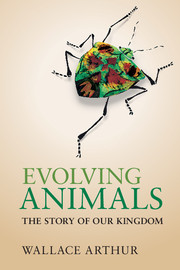Book contents
- Frontmatter
- Dedication
- Contents
- Preface
- Acknowledgements
- 1 What is an animal?
- 2 Before there were animals
- 3 How to make a fossil
- 4 The Cambrian explosion
- 5 How to make a species
- 6 Jellyfish and their kin
- 7 How to make a tree
- 8 The enigmatic urbilaterian
- 9 Animal symmetry and heads
- 10 A plethora of worms
- 11 Trends in animal complexity
- 12 Where the octopus is king
- 13 How to make an animal
- 14 Exoskeletons galore
- 15 Extinction
- 16 Mouth first, mouth second
- 17 Comparing embryos
- 18 Larvae, mouthparts and moulting
- 19 The animal toolkit
- 20 Vertebrate origins and evolution
- 21 From water to land to water
- 22 Variation and inheritance
- 23 Evolutionary novelties
- 24 Human origins and evolution
- 25 Animal plasticity
- 26 The nature of adaptation
- 27 The direction of evolution
- 28 Animal extremophiles
- 29 Extraterrestrial animals?
- 30 The ghost in the machine
- Appendix
- References
- Index
16 - Mouth first, mouth second
Published online by Cambridge University Press: 05 August 2014
- Frontmatter
- Dedication
- Contents
- Preface
- Acknowledgements
- 1 What is an animal?
- 2 Before there were animals
- 3 How to make a fossil
- 4 The Cambrian explosion
- 5 How to make a species
- 6 Jellyfish and their kin
- 7 How to make a tree
- 8 The enigmatic urbilaterian
- 9 Animal symmetry and heads
- 10 A plethora of worms
- 11 Trends in animal complexity
- 12 Where the octopus is king
- 13 How to make an animal
- 14 Exoskeletons galore
- 15 Extinction
- 16 Mouth first, mouth second
- 17 Comparing embryos
- 18 Larvae, mouthparts and moulting
- 19 The animal toolkit
- 20 Vertebrate origins and evolution
- 21 From water to land to water
- 22 Variation and inheritance
- 23 Evolutionary novelties
- 24 Human origins and evolution
- 25 Animal plasticity
- 26 The nature of adaptation
- 27 The direction of evolution
- 28 Animal extremophiles
- 29 Extraterrestrial animals?
- 30 The ghost in the machine
- Appendix
- References
- Index
Summary
The shape of the animal kingdom, as we see it today, has been sculpted both by origins and by extinctions. Having examined extinctions, we now return to the more positive side of the evolutionary process: origins. But what, in an evolutionary context, is an origin? Every species of animal that has ever lived began by evolutionary modification of its parent species. And all animal groups (or clades, as we now think of them) have their origins within other clades – such as the birds within the dinosaur clade, as we noted in the previous chapter. There is no such thing as the magical de novo origin of any new animal species, or any new animal group, devoid of a history of ancestors.
Having said that, some origins are inherently more interesting than others, and for at least two reasons. At the level of the individual animal species, there is more interest in the origin of Homo sapiens than of any other species for the obvious reason that we are particularly fascinated by our own roots. And this kind of self-interest can extend from individual species to higher-level groups – for example, going back through time, to the origin of the primates, the mammals and the vertebrates.
- Type
- Chapter
- Information
- Evolving AnimalsThe Story of our Kingdom, pp. 156 - 165Publisher: Cambridge University PressPrint publication year: 2014



